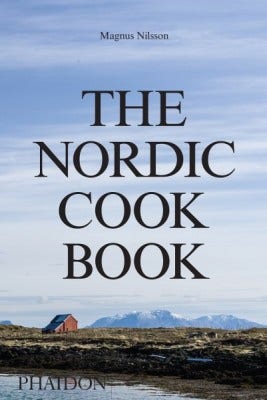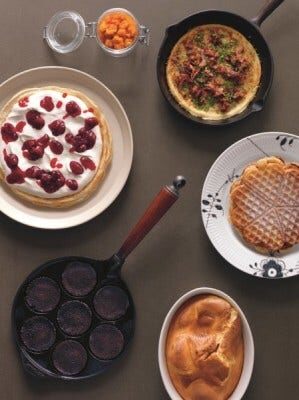Fox & Food: The Nordic Cookbook
Swedish chef Magnus Nilsson, the man behind one of the most remote and unique restaurants in the world, sits down with Fox News Radio’s Lilian Huang Woo to talk about The Nordic Cookbook. Hear all about his year-long wait list, cooking puffin and how to make your own cured salmon.
SPLIT PEA SOUP
Adapted from The Nordic Cookbook by Magnus Nilsson
(Phaidon, $49.95 US/$59.95 CAN, October 2015)
This hearty and warming soup has been a staple in the Nordic region for a very long time. Historically, the protein-rich dried peas were a reliable source of nutrition through winter and they have been eaten in the Scandinavian countries since the Bronze Age, if not before.
The base of the soup is the peas themselves, boiled with vegetables and, usually, with salted meat. The kinds of meat, vegetables and seasonings used differ a bit from country to country. Yellow dried split peas are used everywhere, except in Finland, where green dried split peas are used. In Sweden and Finland pea soup is traditionally eaten on Thursdays, with Thin Pancakes (page 450) for dessert. This tradition dates back to before the Reformation and was a way of preparing for fasting on Fridays. Thursday as ‘pea soup day’ is a tradition that has been kept alive – especially within the military community of Sweden and Finland where it is still very common.
Sometimes the meat used for the soup, which is always boiled in one whole piece, is cut into smaller pieces before serving and then added back to the soup. I am not a huge fan of this. I think it turns this fantastic dish into sloppy canteen food. I prefer to cut the pieces of meat and serve them separately to the soup. This way everyone can add what meat they want to the soup and you can serve it in nice slices as opposed to tiny chopped up pieces. For the same reason I think that the table should be set with a knife and fork as well as a spoon, not just a spoon.
SPLIT PEA SOUP BASE RECIPE
Use the quantities and method from this base recipe as a guide for the regional versions, varying the meat, vegetables and aromatics, as specified.
Preparation and cooking time: 1½ hours
Soaking time: overnight
Serves: 6
Ingredients
- 450 g/1 lb (2¼ cups) yellow split peas
- 1 onion, finely chopped
- 400 g/14 oz boned salted meat, or 800 g/1¾ lb meat on the bone
- vegetables, as specified in the recipes below and overleaf
- aromatics, as specified in the recipes below and overleaf
- salt and white pepper, to taste
Instructions
Soak the split peas overnight in plenty of cold water. They will swell significantly as they absorb water, so make sure you use a large enough container.
Skim away any free-floating pea skins from the surface of the soaking water, then drain the peas and put them in a large pot with 1½ litres/50 fl oz (6¼ cups) fresh water. Add your choice of vegetables, meat and aromatics and season lightly with salt and pepper. (Remember that the salty meat will add to the saltiness of the soup itself, so it’s best to salt more at the end than too much in the beginning.) Bring to the boil and skim carefully during the first 10 minutes of cooking. Continue to simmer over gentle heat until the meat is fully cooked, then remove it from the soup and reserve for later. Continue cooking the peas if they are not completely soft. The whole cooking process should take about 1½ hours.
Before serving, slice the meats and serve them separately (or cut into small pieces and add them back to the soup). Adjust the seasoning before serving.

Click HERE to listen to more FOX & Food podcasts

SWEDISH BEEF STEW WITH ALLSPICE
Adapted from The Nordic Cookbook by Magnus Nilsson
(Phaidon, $49.95 US/$59.95 CAN, October 2015)
Kalops/Skånsk kalops (Sweden)
Kalops is a simple, traditional and very popular Swedish stew, consisting of beef and onions, some bay leaf and a bit of allspice. If you add carrots it turns into Scanian kalops, which is probably the version most Swedes actually mean
when they talk about kalops.
Personally, I like to add a good dash of Ättika (12%) vinegar (page 656) and some brown sugar (brun farin), because I like this dish to be a bit sweet-and-sour. This is really wrong, but very tasty.
Kalops is usually served with Boiled Potatoes (page 117) and Pickled Beetroot (page 660).
Preparation and cooking time: 2 hours
Serves: 4
Ingredients
- butter, for frying
- 1kg/2¼ lb beef chuck, cut into 4 cm/ 1½ inch pieces
- 1 tablespoon plain (all-purpose) flour
- 1 bay leaf
- 12 allspice berries
- 2-3 onions, quartered
- 3 carrots, cut into 1 cm/½ inch slices (optional)
- 3 tablespoons Ättika (12%) vinegar (page 656), optional
- 3 tablespoons brown sugar (optional)
- salt and white pepper, to taste
Instructions
Melt a little butter in a heavy-bottomed pot. Add the beef to the pan and sift over the flour while it is frying. Brown the beef fairly well, and just before it gets too dark, and as the meat proteins and flour stuck to the bottom of the pot get too dark, pour in enough water to cover. Bring to a simmer, then add the bay leaf and allspice and season well. Add the sugar and vinegar, if using.
Cover the pot and cook for about an 1 hour or so, or until the meat is becoming tender. Add the onion to the pot, along with the carrots, if you are using them. Cover again and cook until the vegetables are tender. Taste and adjust the seasoning.
*ADDITIONAL RECIPES
ÄTTIKA
Ättika is a solution of acetic acid in water used as vinegar in the Nordic region. It is most often produced by oxidization of wood alcohol or as a by-product from the paper industry. This crystalclear vinegar is sold in several concentrations of acetic acid that are suitable for different purposes.
Solutions of acetic acid in water similar to this are available in most countries under different names, – often something along the lines of ‘distilled white vinegar’ or just ‘white vinegar’. In Central Europe it is mostly used for cleaning and is sometimes found around the cleaning supplies.
Absolut ren ättika 24% is not suitable for consuming before diluting with water, but it is space-saving, in comparison to lower concentrations. It can also be used to polish windows and remove calcium stains on hard surfaces like stainless steel work counters and sinks. If your room smells of smoke or is musty it is said that ättika in a saucer left overnight absorbs the smell. If there is any actual absorption taking place or if it is the smell of the vinegar itself rather covers any previous smell is perhaps a debatable fact.
Ättika/Ättikssprit 12% is what is used in recipes if Ättika is mentioned and no other concentration is specified. Equal parts absolut ren Ättika 24% and clean water makes Ättika/Ättikssprit 12%.

Follow Lilian Woo on Twitter: @LilianNY






